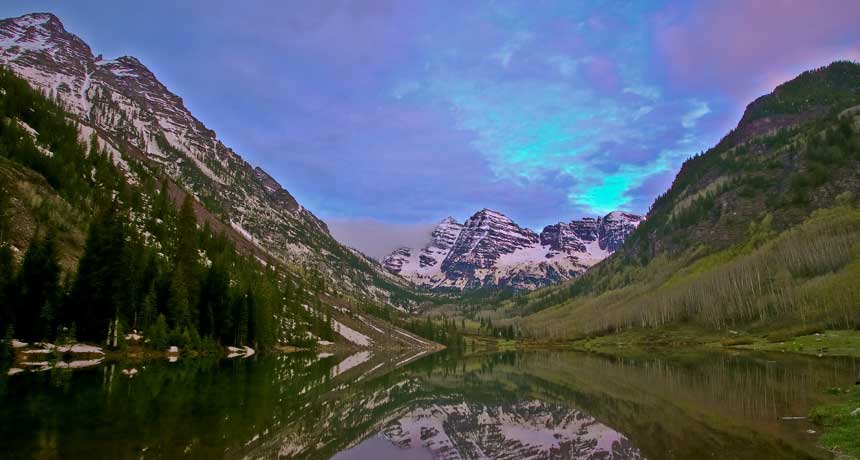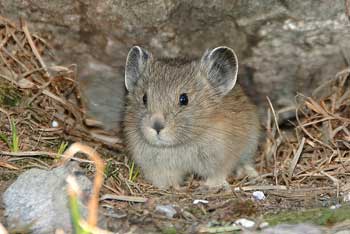Too hot? Some peaks offer climate migrants lots of land
Animals fleeing up mountains for cooler temps may find a surprising amount of real estate awaits

A mountain vista in Aspen, Colo. As animals climb to higher elevations, they might find more usable terrain in which to live than was available below. That’s because many mountains have large regions up there that are reasonably flat — not a sharp, steep wall of rock.
K. Scott Jackson/USGS
By Beth Geiger
Pikas like it cool. That’s why, as Earth’s climate warms, these furry mountain creatures are heading uphill. They’re searching for the chillier environments they prefer. And pikas aren’t alone. A 2011 study found that many mountain species have been shifting their range. They’ve been moving uphill by an average of 11 meters (36 feet) every decade since the 1960s.
Scientists had assumed this would be bad news for the refugees. For one, the higher up a mountain they traveled, the less space that should be available to house them. After all, mountains are shaped like pyramids, right?
Not necessarily, a new study concludes.
In many mountain ranges, animals like pikas and birds may actually gain ground when they head uphill, the study shows. Paul Elsen is an ecologist at Princeton University in New Jersey. His team published its observations on May 18 in Nature Climate Change.
Most researchers figured that the real estate available to migrating species would shrink the higher uphill they moved. If true, that would suggest that many global-warming migrants might run out of new sites to colonize — and face extinction.

But Elsen started to have his doubts about this while he was studying birds in the Himalayas. That’s a massive mountain range in East Asia. “I would hike up and reach these broad plateaus,” he recalls. He realized that such land features might actually offer more usable real estate to some species than they had had available to them on the steep slopes below.
Back home, the PhD student paired up with ecologist Morgan Tingley, who was at Princeton at that time. (Tingley now works at the University of Connecticut in Storrs.) The two men obtained detailed data on the general topography — the shape of the land surface — of 182 mountain ranges around the world. They then added precise measurements of the elevations of each mountain within each range. They plotted the surface area of each peak versus its elevation, or height, as a graph. Scientists refer to such mappings as hypsographs (HIP-so-grafs).
When viewed close up, these graphs revealed that most mountains are not like the picture-postcard pyramid that most people imagine. In fact, the actual surface area at each height above sea level depends a lot on the peak’s local topography. For instance, do deep ravines cut through its surface? Do broad flat plateaus stretch out toward a distant horizon? Or do steep rock faces rise up offering few toe-holds for plants or animals to hang onto?
Like the classic pyramid, some mountain ranges did have less livable area higher up. Yet others had more surface area in their middle elevations, much as an upward-standing diamond does. About a fourth of mountains host most of their surface area at the bottom and the top. That gives their hypsographic curve an hourglass shape. Still other mountain ranges have more surface area higher up, almost like an upside-down pyramid.
The Princeton team was surprised. “I had no idea that it would be so different from our perception,” Elson told Science News for Students. The findings mean that mountain species may often gain more room to spread out and nestle in as they migrate uphill. That could benefit, rather than stress, a species seeking refuge from the heat.
Terry Root is an ecologist at Stanford University in Palo Alto, Calif. She has been focusing on how climate change affects animals and plants. The work by Elsen and Tingley is “elegant,” she says. “It is an important contribution to understanding what species will face as the climate changes.”
Of course, Elsen notes, plants and animals need more than just room to roam or make their homes. They also need suitable food and water, among other things. Still, he says, the new analyses are important for ecologists to consider. Elsen believes the findings may change the way scientists evaluate the impacts of climate change on mountain species.
Power Words
(for more about Power Words, click here)
climate The weather conditions prevailing in an area in general or over a long period.
climate change Long-term, significant change in the climate of Earth. It can happen naturally or in response to human activities, including the burning of fossil fuels and clearing of forests.
ecology A branch of biology that deals with the relations of organisms to one another and to their physical surroundings. A scientist who works in this field is called an ecologist.
environment The sum of all of the things that exist around some organism or process and the conditions they create for that organism or process. Environment may refer to the weather and ecosystem in which some animal lives, or, perhaps, the temperature, humidity and placement of components in some electronics system or product.
habitat The area or natural environment in which an animal or plant normally lives, such as a desert, coral reef or freshwater lake. A habitat can be home to thousands of different species.
hypsograph (also called hypsographic curve) A graph that shows relative area versus relative height.
migration (v: to migrate) Movement from one region or habitat to another, especially regularly and according to the seasons.
PhD (also known as a doctorate) A type of advanced degree offered by universities — typically after five or six years of study — for work that creates new knowledge. People qualify to begin this type of graduate study only after having first completed a college degree (a program that typically takes four years of study).
pyramid A monumental structure with a square or triangular base and sloping sides that meet in a point at the top. The best known are those made from stone as royal tombs in ancient Egypt.
range The full extent or distribution of something. For instance, a plant or animal’s range is the area over which it naturally exists.
species A group of similar organisms capable of producing offspring that can survive and reproduce.
topography The surface shape and features of an area.







